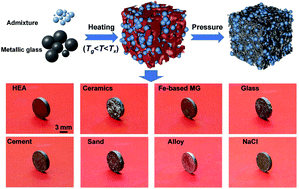Metallic glue for designing composite materials with tailorable properties†
Abstract
Developing materials with tailorable properties has been the long-sought goal of humankind. Forming composite materials with superior properties by combining two or more materials has emerged as a competitive means in the search and design of new materials. However, it is still a grand challenge to use metallic materials as a binder for composites because of their lack of adhesion. In the present work, we proposed a facile and flexible route to synthesize composites using metallic glass as a glue to bond various materials, ranging from conductors to insulators, and metals to nonmetals, together. The mechanical, magnetic and electrical performances of the composites can be manually regulated by changing the addition ratios of the metallic glass glue and the corresponding admixture. In addition, porous structures were also obtained and tuned by dissolving the soluble admixture in water. In principle, our approach provides a new idea for the fabrication and optimization of composites using metallic materials as binders. The outcome of our current research opens up a window not only to synthesize composite materials with tailorable properties universally and flexibly, but also towards the discovery of potential multi-functional metal containing composites.



 Please wait while we load your content...
Please wait while we load your content...